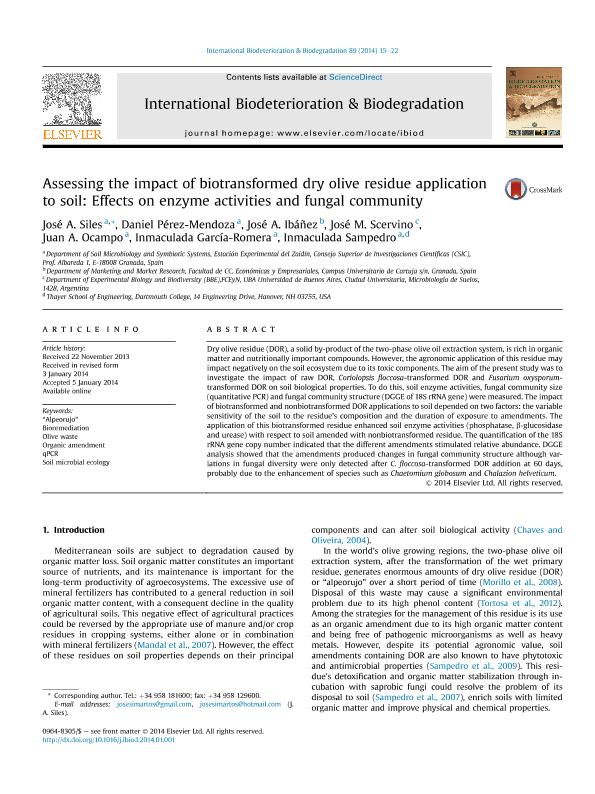Artículo
Assessing the impact of biotransformed dry olive residue application to soil: Effects on enzyme activities and fungal community
Siles, José A.; Perez Mendoza, Daniel; Ibañez, José A.; Scervino, Jose Martin ; Ocampo, Juan A.; Garcia Romera, Inmaculada; Sampedro, Inmaculada
; Ocampo, Juan A.; Garcia Romera, Inmaculada; Sampedro, Inmaculada
 ; Ocampo, Juan A.; Garcia Romera, Inmaculada; Sampedro, Inmaculada
; Ocampo, Juan A.; Garcia Romera, Inmaculada; Sampedro, Inmaculada
Fecha de publicación:
01/2014
Editorial:
Elsevier
Revista:
International Biodeterioration And Biodegradation
ISSN:
0964-8305
Idioma:
Inglés
Tipo de recurso:
Artículo publicado
Clasificación temática:
Resumen
Dry olive residue (DOR), a solid by-product of the two-phase olive oil extraction system, is rich in organic matter and nutritionally important compounds. However, the agronomic application of this residue may impact negatively on the soil ecosystem due to its toxic components. The aim of the present study was to investigate the impact of raw DOR, Coriolopsis floccosa-transformed DOR and Fusarium oxysporumtransformed DOR on soil biological properties. To do this, soil enzyme activities, fungal community size (quantitative PCR) and fungal community structure (DGGE of 18S rRNA gene) were measured. The impact of biotransformed and nonbiotransformed DOR applications to soil depended on two factors: the variable sensitivity of the soil to the residue?s composition and the duration of exposure to amendments. The application of this biotransformed residue enhanced soil enzyme activities (phosphatase, b-glucosidase and urease) with respect to soil amended with nonbiotransformed residue. The quantification of the 18S rRNA gene copy number indicated that the different amendments stimulated relative abundance. DGGE analysis showed that the amendments produced changes in fungal community structure although variations in fungal diversity were only detected after C. floccosa-transformed DOR addition at 60 days, probably due to the enhancement of species such as Chaetomium globosum and Chalazion helveticum.
Palabras clave:
Alpeorujo
,
Bioremediation
Archivos asociados
Licencia
Identificadores
Colecciones
Articulos(INIBIOMA)
Articulos de INST. DE INVEST.EN BIODIVERSIDAD Y MEDIOAMBIENTE
Articulos de INST. DE INVEST.EN BIODIVERSIDAD Y MEDIOAMBIENTE
Citación
Siles, José A.; Perez Mendoza, Daniel; Ibañez, José A.; Scervino, Jose Martin; Ocampo, Juan A.; et al.; Assessing the impact of biotransformed dry olive residue application to soil: Effects on enzyme activities and fungal community; Elsevier; International Biodeterioration And Biodegradation; 89; 1-2014; 15-22
Compartir
Altmétricas



